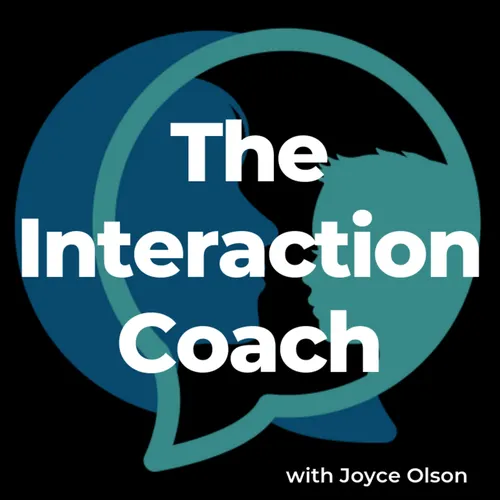
The Interaction Coach
You can help your child learn to talk with speech-language pathologist Joyce Olson of The Interaction Coach. Listen to daily tips that make every interaction a learning opportunity for speech and language development. Whether your child needs to start using words, make longer sentences, or improve social communication, this podcast is for you.
- Update frequency
- every day
- Average duration
- 6 minutes
- Episodes
- 234
- Years Active
- 2019 - 2020

episode 1.233 - 4:1:20, 9.09 PM
This activity gives your child a chance to play independently with markers or crayons in a controlled space.
Today’s activity: Use a large box that your child can sit inside comfortably.
Learn about …

6.232 LITERACY: Writing: Paint with water
Painting is fun. It’s another way to practice holding a writing tool and using eye-hand coordination.
Today’s activity: Use a small bowl of water for your child to dip the paintbrush in. Paint on col…

6.231 LITERACY: Writing: Practice pincer grip
At this level your child will develop a pincer grip with index finger and thumb, move arm across midline and scribble with a variety of writing tools.
Today’s activity: Practice using pincer grip, pi…

6.230 LITERACY: Reading: Quit before the interest is gone
By the end of this level, your child should look at books with you for at least 5 minutes. They need to learn that time with books is pleasant. The trick is to be done before your child starts squirm…

6.229 LANGUAGE: Literacy: Encourage independent reading
Children at this level like to look at books on their own. If it’s one you’ve read with them, they will look for favorite pictures or turn pages back and forth. You might hear them talking out loud a…

6.228 LANGUAGE: Use Speech: Accept any pronunciation
Children at this level are not able to use all the speech sounds. They use consonants at the beginning of a word more often than to one at an end of the word. It’s often hard to understand their spee…

6.227 LANGUAGE: Use Speech: Model “What’s that?”
Asking for information is an important function of communication. Children learn how to ask questions from your examples. When you model the question and then the answer, they learn they can go to yo…

6.226 LANGUAGE: Use Speech: Model word when child is watching face
When your child is interested in something, they are more likely to want to talk about it. They will be interested in the word you use to label it.
Today’s activity: When your child is interested in …

6.225 LANGUAGE: Use Speech: Blow on objects
Your child is learning how to coordinate their movements in more precise ways. For speech, they need to coordinate all the muscles from their chest up to their mouth. They need to control air flow fr…

6.224 LANGUAGE: Use Speech: Model sound effects
When you rchild uses an animal sound or car sound, they’re expressing a meaning. You understand what they’re talking about. That’s communication.
Take advantage of your child’s natural interests to e…

6.223 LANGUAGE: Make Meaning: Model “eat” gesture
Put your thumb and fingers together to mime an eating movement. Use lots of modeling before you start to expect your child to use the gesture.
Today’s activity: Model “eat” when you are opening the f…

6.222 LANGUAGE: Make Meaning: Model “high five” gesture
Send your questions to [email protected].
“High five” is a great example of how we shape a new gesture. People naturally make the offer and then wait. Always give your child a chance to make …

6.221 LANGUAGE: Make Meaning: Model “I don’t know” gesture
This gesture is made with both arms, hands up and out to the side. You can include a shoulder shrug. This was introduced in earlier activities when you ask, “Where is…?” You look around and use this …

6.220 LANGUAGE: Make Meaning: Model “wait” gesture
Hold your flat hand palm up and toward your child. Say the word “wait” as you make the gesture. Model the gesture frequently. Pause or do one short thing and then do something with your child.
Your c…

6.219 LANGUAGE: Make Meaning: Model “stinky” gesture
The gesture for “stinky” is waving your hand in front of your face, while making a face and saying “Pew!” Its function of communication is to entertain. Many children learn it because it’s funny and…

6.218 LANGUAGE: Make Meaning: Model “yes” when asking “Do you want?”
Your child needs lots of models and experience to understand and use a head nod or thumbs up for “yes.” “Yes” is harder to learn than “no.”
When your child moves their face away from offered food, we…

6.217 LANGUAGE: Make Meaning: Model “my”
“My” is a pronoun, another type of word to add to your child’s vocabulary. It’s a word that has a lot of meaning for your child!
Today’s activity: Model a gesture (or symbol) as you say the word “my”…

6.216 LANGUAGE: Make Meaning: Model “more” to repeat something
The word “more” can come in handy at many times and places to ask for something to be repeated. Model a gesture along with the word. Remember your child needs LOTS of models before they begin to use …

6.215 LANGUAGE: Make Meaning: Model “all done”
Your child needs lots of your modeling before they express a word. You usually can’t practice today’s word several times in a row (because you’re just all done once!) but your child can experience it…

6.214 LANGUAGE: Make Meaning: Model words for actions
Your child needs to learn a variety of types of words—verbs, nouns, adjectives—so they can combine them when they’re ready to make 2-word combinations. Verbs (action words) can be used to describe or…